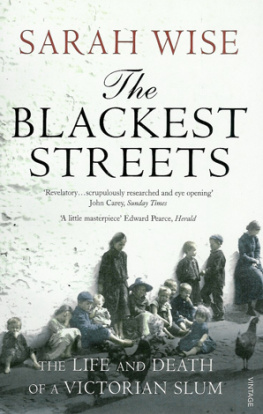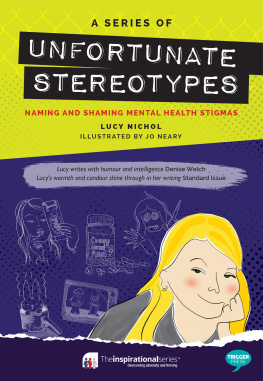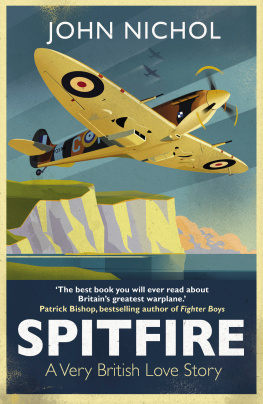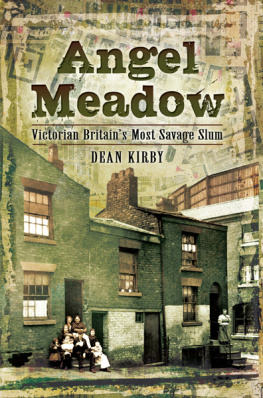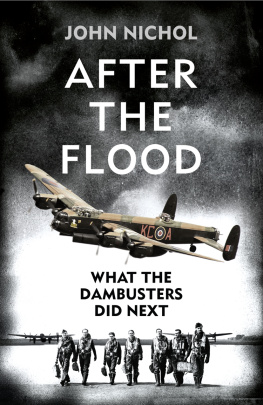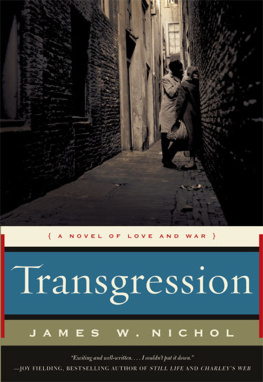Contents
About the Author
Sarah Wise is the author of The Italian Boy: Murder andGrave-Robbery in 1830s London, which was shortlistedfor the 2005 Samuel Johnson Prize for Non-Fiction andwon the Crime Writers Association 2005 Gold Daggerfor Non-Fiction. She lives in central London and reviewsfor the Daily Telegraph and the Literary Review.
About the Book
In 1887 Government inspectors were sent to investigate the Old Nichol, a notorious slum on the boundary of Bethnal Green parish, where almost 6,000 inhabitants were crammed into thirty or so streets of rotting dwellings and where the mortality rate ran at nearly twice that of the rest of Bethnal Green. Among much else they discovered that the decaying 100-year-old houses were some of the most lucrative properties in the capital for their absent slumlords, who included peers of the realm, local politicians and churchmen.
The Blackest Streets is set in a turbulent period of Londons history when revolution was in the air, and award-winning historian Sarah Wise skilfully evokes the texture of life at that time, not just for the tenants but for those campaigning for change and others seeking to protect their financial interests. She recovers Old Nichol from the ruins of history and lays bare the social and political conditions that created and sustained this black hole which lay at the very heart of the Empire.
SARAH WISE
The Blackest Streets
The Life and Death of a Victorian Slum

For my mother, Daphne May, 19292009
Twas August, and the fierce sun overhead
Smote on the squalid streets of Bethnal Green,
And the pale weaver, through his windows seen
In Spitalfields, looked thrice dispirited.
I met a preacher there I knew, and said:
Ill and oerworked, how fare you in this scene?
Bravely! said he; for I of late have been
Much cheered with thoughts of Christ, the Living Bread....
Matthew Arnold, East London
I thank the Lord for what Ive had,
If I had more I should be glad,
But now the times they are so bad,
I must be glad for what Ive had.
Grace, as sung by children receiving charity dinners in the Old Nichol
The poetry of history lies in the quasi-miraculous fact that once, on this earth, once, on this familiar spot of ground, walked other men and women, as actual as we are today, thinking their own thoughts, swayed by their own passions, but now all gone, one generation vanishing into another... The Dead were, and are not. Their place knows them no more, and is ours today. Yet they were once as real as we, and we shall tomorrow be shadows like them.
G.M. Trevelyan
Acknowledgements
Huge thanks are due to Alison Light of the Raphael Samuel History Centre at the University of East London for allowing me to quote extensively the wonderful material that her late husband harvested in his interviews with Arthur Harding; the result of that work, East End Underworld: Chapters in the Life of Arthur Harding (1981), is long overdue for a reprint. Thanks also to Annette Day, Senior Curator of the Museum of Londons Oral History & Contemporary Collecting Department, for permission to listen to and quote from Samuels original tape recordings; those quotations appear by kind permission of the Museum and of the trustees of the Raphael Samuel Estate.
Stewart P. Evans, crime historian and indefatigable Ripper-hunter, told me that journalist Donald McCormick was the source of one of the worst libels of the Old Nichol district, and I am extremely grateful to him for his generosity in sharing with me his research on this aspect of Ripper lore.
John Davis of Queens College, Oxford, has been a great guide to the complicated franchise arrangements of late-Victorian London, and the detailed research that he and colleague Duncan Tanner undertook in the 1980s on the electoral rolls of East London have proved invaluable for my attempts to assess the true level of political engagement of the slums residents.
Charles Booths granddaughter, Belinda Norman-Butler, and her nephew, Richard Martineau, kindly granted me permission to quote from the notebooks and papers of the Booth Archives, held at the London School of Economics, and I am grateful to Sue Donnelly and the staff of the Archives, too, for their helpfulness over many visits.
Peter Guillery of English Heritage shared with me his expertise on Londons eighteenth-century small buildings. Nicholas Malton of the NSPCC kindly allowed me to access that organisations archives and pointed me towards further useful reading; while John Nicholls and Christine Romanowski of the London City Mission generously revealed the treasures in their small archive in Tower Bridge Road.
Thanks also to the helpful and friendly staff of the Library at Lambeth Palace; the London Metropolitan Archives; the British Librarys Social Sciences room at St Pancras, and Newspaper Library at Colindale; Malcolm Barr-Hamilton and Christopher Lloyd of Tower Hamlets Local History Library and Archive; the Guildhall Library and Prints Room; Rachel Roberts, archivist of Cheltenham Ladies College, and Rupert Williams of St Hildas East, in Old Nichol Street; Jonathan Evans of the Royal London Hospital Archives and Museum; Natalie Hill of the Buildings Team at the National Monuments Record; and Clare Rider and Adrian Blunt at the Library and Archives of Inner Temple. Lucinda Rogers, Leila McAlister and Jean Locker told me what life around the Bandstand is like today.
Thank you to Will Sulkin and Jrg Hensgen, publisher and editor respectively. Prue Jeffreys and Vanessa Taylor invaluable, wise counsel, as ever. Peter Neish, thanks for everything, once again.
PART ONE
DEAD LETTERS
The Empire of Hunger
AT FOUR OCLOCK in the afternoon of a damp, chilly Saturday in November 1887, two men kept an appointment with each other at Shoreditch railway station. Both were Continental revolutionaries one, a Communist, wished to reveal to the other, an Anarchist, the very worst face of poverty he had discovered in the East End during his stay in London.
The Communist led the Anarchist into the nearby Hackney Road, then turned south, into the maze-like streets of the area known as the Old Nichol. The bustle of the main road suddenly ceased, and as the two walked southwards the streets grew narrower and darker canyons of two- and three-storey housing, stretching as far into the distance as the mist and drizzle allowed them to see. The Anarchist soon became disorientated by the repeated left turnings, right turnings, his friend was making, and felt strangely unsettled by the symmetry of the streets, the monotony of the blackened buildings and the repetitive vistas revealed on their convoluted journey. This appeared to him to be a world leached of colour: wherever he looked, all he could discern were various shades of grey. After five minutes of walking, the Communist took the Anarchist down a narrow passage (so narrow they had to turn sideways and move crabwise along) that ran between two houses and into a tiny square surrounded on all sides by tenement buildings. He motioned to a small mound of earth rising between pools of filthy liquid and, as bidden, the Anarchist took his stand upon the mound the better to survey the scene. There was no one in sight, and although they could make out the distant, subdued roar and rumble of the four busy streets that boxed the Old Nichol in, there was no sound nearby. There was not a blade of grass to be seen, but heaps of what looked like rubbish, broken furniture and the like; in one corner lay the carcass of a dog, and here and there a rag of grey linen on a clothesline hung motionless in the cold air. The stone steps leading to the tenement doorways were worn down by generations of feet; every window pane was cracked, some smashed; thin columns of smoke rose from a few of the chimneys and dispersed into the mist. The Anarchist thought that it looked as though death had just passed in giant strides through these streets and touched all breathing things with his redeeming hand. Redeeming: the Anarchist saw death as a blessing in such a place as this.
Next page
